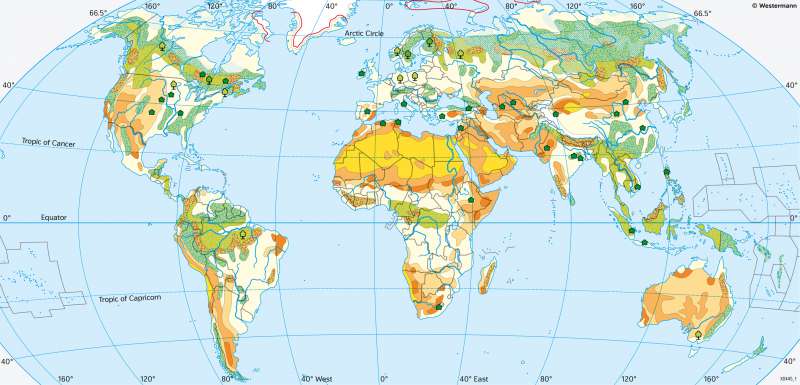The World - Landscape changes
Ecozones and natural hazards
978-3-14-100890-6 | Page 22 | Ill. 2

Overview
Forest recession, desertification and the greenhouse effect are phenomena that do not always occur together, but often do, especially in the Earth's arid regions.
Forest loss
Particularly affected by forest decline are parts of the boreal coniferous forest (especially in Russia), the mountain forests in the Himalayas and numerous tropical forests (e.g. Amazon lowlands, West Africa, Madagascar, India, Southeast Asia). The pressure on forests is particularly high in emerging and developing countries with low living standards and high population growth. In many countries in Western and Northern Europe, in North America and in some other regions, however, sustainable forestry has developed in many places, some of which are anchored in law and strive for sustainable use of forest areas.
Desertification
Desertification is a global phenomenon that is increasingly observed in Africa, the Arabian Peninsula, Central Asia, Australia and parts of North and South America. Affected areas include many desert fringe areas where the destruction of soil and vegetation can no longer be compensated by natural regeneration. Strongly affected are areas such as the southern Sahel, which has been massively affected by natural rainfall variability, overgrazing, overcultivation and excessive deforestation. Regions where human pressure on the landscape is growing but not yet excessive are classified as endangered.
Desertification is a complex phenomenon that is essentially human-induced but can be exacerbated by natural factors such as rainfall variability, droughts and the susceptibility of certain soil types to blow-out, fluvial erosion, soil skeletonisation or salinisation. Often, as in the Sahel, desertification is the result of an adverse interaction of increased population pressure, agriculture and lack of rainfall. Once started, the desertification process often develops its own self-reinforcing dynamics. There are measures to combat desertification, such as special agricultural and technical methods. However, since the necessary funds for their implementation are lacking in most affected countries, many processes must be regarded as irreversible.
Greenhouse effect
The main cause of global warming is the increased emission of greenhouse gases since the beginning of industrialisation. The most important greenhouse gas is carbon dioxide (CO2), which is produced by burning the fossil fuels coal, oil and natural gas. Around 1860, about 340 million tonnes of CO2 were released annually; today the figure is more than a hundred times higher. In the Kyoto Protocol, the first major climate protection agreement, more than 170 countries committed themselves to drastically reducing their CO2 emissions. Nevertheless, according to the Intergovernmental Panel on Climate Change (IPCC), they have continued to rise and will reach new record levels this decade.
The most important causes of rising greenhouse gas emissions are population and economic growth. The energy sector (35%) is primarily responsible, followed by agriculture and forestry (24%), industry (21%), transport (14%) and buildings (6%).
With a moderate increase in climate-impacting greenhouse gases, there will be a rise in temperature in the polar regions of the northern hemisphere. By the year 2100, an increase of over 7°C is predicted there in some cases, not least because of the shorter average duration of snow cover and melting ice. The snow- and ice-free ground surfaces will warm up even more due to their lower albedo, their reduced reflectivity (positive feedback). In the Antarctic, a smaller temperature increase than in the Arctic is expected. Here, the isolated location and the thick inland ice masses contribute to a significantly lower temperature increase. Another positive feedback process occurs in areas where permafrost is currently widespread. There, as temperatures rise and the ground thaws, large quantities of methane, a gas that affects the climate, are released. Once released into the atmosphere, it intensifies the greenhouse effect there.




